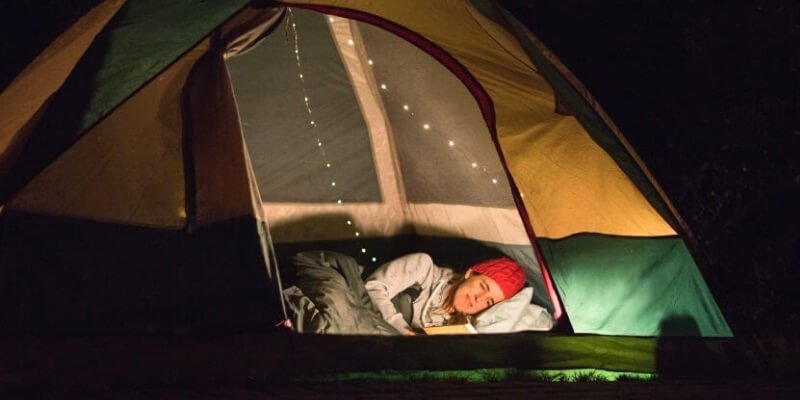
As typical city kids, we look forward to every camping holiday in nature. The simple life is appealing but unfamiliar for beginners. Sleep problem when camping is therefore common. The unfamiliar terrain, ambient sounds, and varying temperatures can disrupt even the most seasoned camper’s slumber.
However, with a few essential tips and a touch of preparation, you can transform your tent into a sanctuary of comfort and tranquility. Today, we will unveil the 10 invaluable insights to help you master the art of sleeping soundly in the great outdoors.
1. Learn where the tent is set up in daylight
This tip applies to festival campers and wild campers alike. My experience has taught me that pitching a tent in the dark is stressful – even if I know every move. Stress is bad: Stress just before going to sleep can significantly increase the time it takes for us to relax and fall asleep. A lack of lighting and a reduced ability to concentrate on the other increase the error rate when setting up a tent in the dark.
As a festival camper and campsite holidaymaker, it is worth arriving particularly early to secure the coveted parcels. In daylight, the assembly is also much more fun. In daylight, it is much easier for beginners to find friendly fellow campers who can help set up their tents if something doesn’t work out. Also, pay attention to the weather forecast for the night and pack appropriate things for camping in the rain.
2. Find a suitable place for your tent
Preparation is crucial when setting up your tent. Take the first tip to heart and have enough time to find a suitable place for the tent, so we can crawl into the sleeping bag calmly and relax.
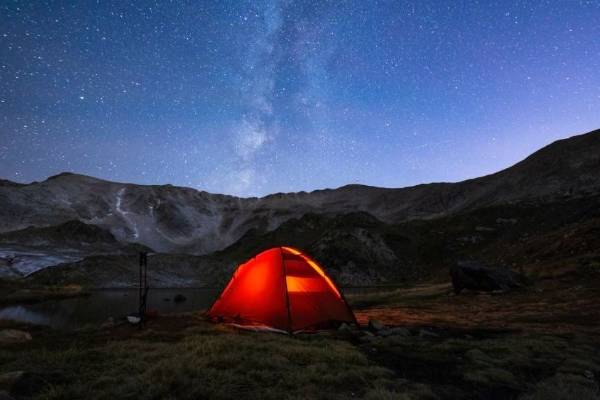
The subsurface should be as level as possible. There should be no depressions, holes in the ground or noticeable slopes.
Pay attention to sharp stones, branches, and other items from your targeted installation. If have, remove them because it can cause damage to the tent floor. The quality of sleep can deteriorate enormously as a result of these factors. Those who sleep on the floor sometimes have painful experiences in the underground and have to fight pressure points or back problems the next day.
Also, pay attention to the wind and the dangers of camping with thunderstorms and lightning. Choose a place that is sheltered from the wind as well as possible and safe from lightning strikes. This is the only way to have a restful sleep in the tent when the weather conditions worsen.
A tunnel tent is prone to crosswinds. If you set up a tunnel tent, make sure to put up the narrow side in the direction of the wind. This will increase the stability enormously, and the tent will not collapse in the middle of the night.
If you pitch your tent in daylight, it is also much easier to unfasten the tent cords and storm lines. The tensioning of your tent cords should be done in a way so that they don’t end too close to the neighboring tent. Otherwise, it can happen that the tent neighbor stumbles over your guy ropes and rudely wakes you up with a loud outcry.
3. Illuminate your tent and surrounding area
Camping in the middle of nature has become rarer because of legal requirements. If you set up your tent camp in the middle of nowhere, you will be amazed at the magnificent starry sky and how dark the night can get.
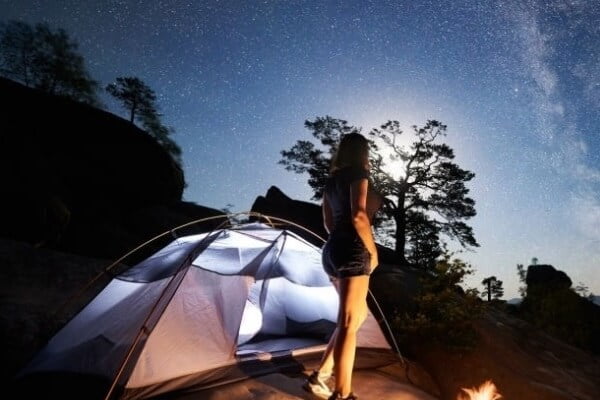
It is even more important that we have the appropriate light sources in our luggage! A handy flashlight is the easiest way to go to the toilet. The smartphone’s flashlight on the other hand is not the best choice. Many tripping hazards are recognized too late or not at all.
However, we recommend a suitable camping lantern for the inside of the tent, which can be attached to hooks on the ceiling in modern tents. When moving, assembling and dismantling at night, you need both hands. Holding the lighting in one hand is not an option. The processes will be made unnecessarily difficult. Therefore, a rechargeable LED headlamp is the best choice.
4. Make a routine to fall asleep
The usual actions that I do at home shortly before going to sleep should be done on the camping trip if possible. This is how I create normality in an otherwise rather unusual situation. This can help the body relax and fall asleep.
The last process is brushing your teeth. Then we clean this (away from the tent) as the very last act before we get into the sleeping bag. Children can use their favorite cuddly toy or another object that they used to fall asleep at home.
5. Wear dry clothes in the sleeping bag
Before you crumble in the sleeping bag, always replace wet clothes with dry ones. This also includes items of clothing that are sweaty. Socks are particularly important for a good night’s sleep when camping. You should avoid cold feet.
A good outfit choice for the sleeping bag: long underwear and clean socks. In this context, avoid wearing too much clothing while lying in a sleeping bag. This is bad because it reduces the sleeping bag’s ability to store body heat!
6. Stay warm inside the tent
It can get very cold in the west on summer nights. The feeling of cold is individual. As a rule, it is sufficient to lie in the sleeping bag with long dry underwear and socks and close the zipper. If you are one of those people who freeze particularly quickly or if you camp in autumn and winter, here are some additional tips against the cold when camping.
Tent heating in damp and cold conditions
It gets really uncomfortable with the combination of cold, humidity, and wet clothing or even wet shoes. I use dry air and warmth to dry wet clothes and boots even in high humidity. I get this with a practical helper: a good tent heater. These electric heaters are comparatively compact, do not weigh much, and are easy to use.
- Practical side effect: The unwanted condensation of water on our tent wall is also reduced!
Find the right sleeping bag
Be sure to choose a sleeping bag that is tailored to your travel destination. Sleeping bags can always be opened with a zipper if you feel too warm. It is therefore worth choosing a sleeping bag with a minimum temperature below the temperature you expect at the travel destination.
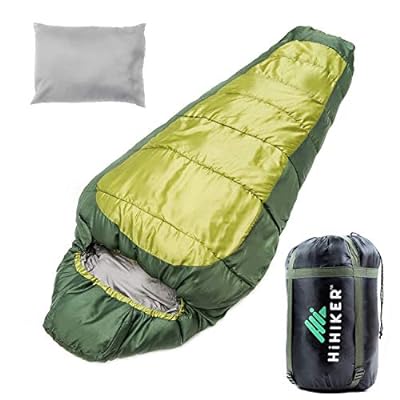
Accordingly, there is a division into summer, three-season, and winter sleeping bags. So if possible, you shouldn’t pack a winter sleeping bag when camping in summer. Mummy sleeping bags like this one keep you warm and are particularly light.
Air mattresses or air beds keep the cold away from the floor
If you don’t sleep on a camp bed in your tent, you should have an air mattress or an air bed in your luggage so that you can keep warm even on icy ground. If you are not on a backpacking holiday, every gram of luggage is usually not important when car camping. Inflatable mattresses with an electric pump, also known as an air bed, are all the more comfortable.
Air beds are significantly higher and more comfortable than air mattresses or sleeping mats, especially when it comes to avoiding floor chill, an elevated air bed like this is an interesting choice. This model even has a raised cushion integrated. If it is particularly uncomfortable in autumn and winter, we put sleeping mats as an additional layer under the air beds.
A pillow keeps your head warm
The head cools down particularly quickly. Therefore, a pillow you bring with you from home is ideal to keep your head warm at night. It is also much easier to fall asleep when your head is comfortably bedded. In the meantime, there are also inflatable pillows in every shape and size. If you have to save space, you can choose one of these models.
Wear a hat
Because we absolutely want to keep our heads warm, I recommend that autumn and winter campers wear a hat in the tent. This makes it easier for you to warm up and take off your headgear if you get too warm.
Sit-ups in a sleeping bag
You should of course avoid strenuous exercise right before going to sleep because of the build-up of perspiration. However, sit-ups in the sleeping bag help wonders: The light exercise heats you up and the sleeping bag at the same time.
7. Light meals before bed keep you warm
A light snack or a smaller meal right before you go to sleep will keep you warm inside. Your body is busy digesting, producing heat that helps you fall asleep in the cold.
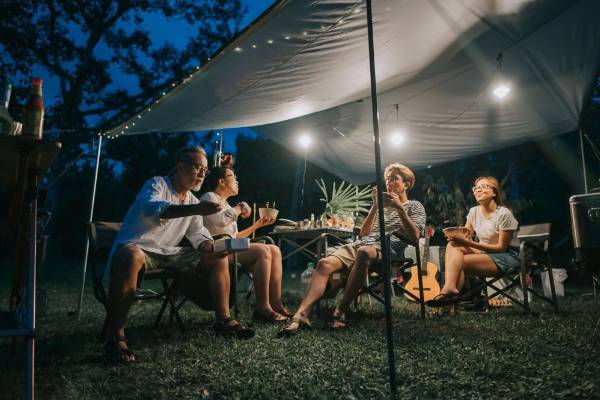
Drinking hot tea right before going to sleep keeps you warm inside. Thermos flasks help: this means we can prepare the hot drink long in advance. On the other hand, you should avoid any form of alcohol, as it expands the capillaries and even accelerates the loss of heat.
A hot water bottle or a heated water bottle is a useful addition for camping in the cold. Take them with you in the sleeping bag for at least a few minutes. It helps if the bottle is placed in the middle of the body. This area of the body produces most of the heat.
8. Increase your body temperature before going to bed
If you ever get a bit cold before going to bed or are planning a fairly cool night, we recommend trying to raise your body temperature (without sweating) before going to bed – ideally not to lose it. This will allow you to fall asleep faster and it is usually easier to do this before you get into your sleeping bag. All means are good, you can run in place, jump, dance, gesture, etc.
Note: the longer you go to bed after your daily effort, the less you will benefit from the effect of “overheating” linked to the effort.
9. Go to the toilet before going to sleep
In general, we recommend going to the toilet twice if possible before you make yourself comfortable in the tent – first about 20-30 minutes beforehand, then again immediately before lying down. This technique can help reduce or even avoid using the toilet at night to a minimum.
Do you remember tip 1?
If you arrive in daylight and know the area well, you can make going to the toilet much easier. At campsites, it is good to have seen the sanitary facilities in daylight. This factor becomes even more important at festivals – especially those where floodlights don’t show the way all night or information boards are set up on every corner.
A shower tent makes sense, especially for festival campers who camp far away from the toilets. This can be equipped with a portable toilet, closed opaque, and thus save a lot of time.
On the other hand, if you have a long hike to the toilet facilities in front of your chest, you will be wide awake again after your return – then it will be even more difficult to fall asleep.
When preparing for night trips to the toilets, it is helpful to have a headlamp or flashlight ready. The shoes should also be ready for use on a mat, doormat or towel. In this way, you can prevent mud and dirt from getting into the tent after using the toilet.
10. Reduce noise
Most of us don’t camp away from the tent and campgrounds. As a wild camper, it happens that noises seem strange to us and have a positive or negative effect on falling asleep. A gentle rustling from the nearby brook can have a calming effect, while noises from wild animals can usually make us nervous.
However, earplugs or wax help immensely to relax. Interfering noises are significantly reduced. These small and practical helpers should not be underestimated, especially at festivals and busy campsites. With us, they are part of the standard equipment in the sleeping cabin.
A second tip to reduce noise for better sleep: tents with magnetic doors. These doors have magnets installed along the inside of the door so that they close cleanly without a zipper. Instead of loud zipper doors, these interior doors with magnetic strips are significantly quieter.
This is an advantage, especially if you sleep with several people in the tent and one of your fellow campers has to go out. The Coleman Tent Galileo 5 is one such tunnel tent with internal magnetic stripe doors.
11. Darken the inner tent
Modern inner tents are equipped with darkened polyester tent fabric. The tent manufacturer Coleman won an award for its technology called “BlackOut Bedroom”. This extra dark bedroom in tents with this name absorbs up to 99 percent of the daylight.
The Coleman Air Valdes 6XL air tent that we tested has such a blackout bedroom. Other manufacturers also have darkened sleeping cabins in their range.
However, if you have problems falling asleep in the light, you should use a tent with darkened cabins. Floodlights on campsites, neighbors’ lighting, or flashlights that shine into your own tent are just a few of the possible scenarios. All of this can significantly delay falling asleep in the tent.
If you are a late riser, you don’t want to be woken up early by the sun in the morning. This is a common problem with conventional tent fabrics.
12. Don’t go to bed too late
Life tends to wake up a little earlier on the campsite. In order to be fit for the next day, you better not stay up too late. Also, if you move a lot during the day, you will fall asleep earlier at night.
Conclusion
Achieving a good night’s sleep in a tent is essential for an enjoyable and successful camping experience. There are many ways to ensure good sleeping conditions when you are camping. If you follow these 12 tips with our realistic experience, you can significantly improve your comfort and restfulness while camping.
Hope this guide allowed you to spend warm nights in your sleeping bag and start again on the right foot the next day. If you liked this article, you can share it with your friends on social media.